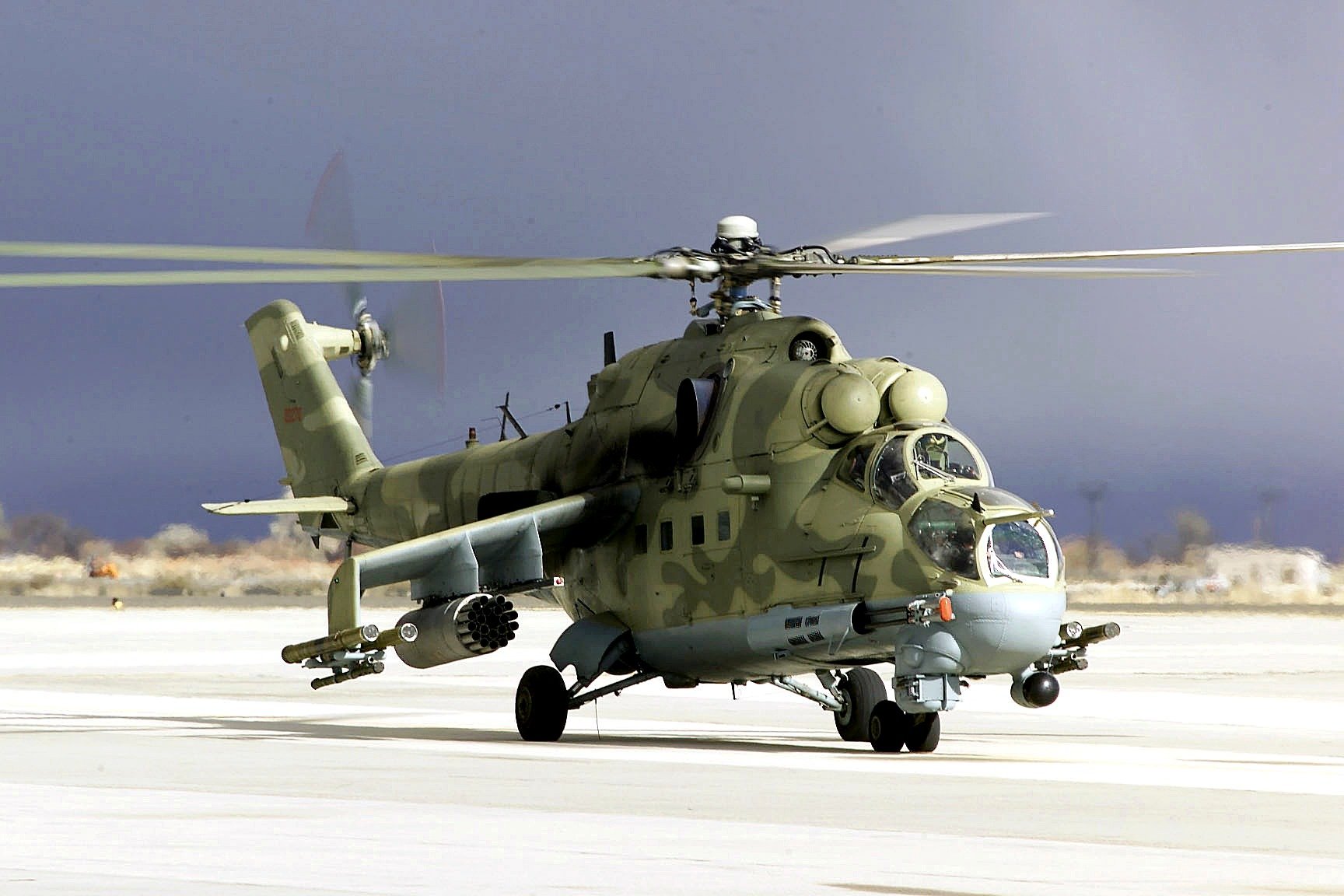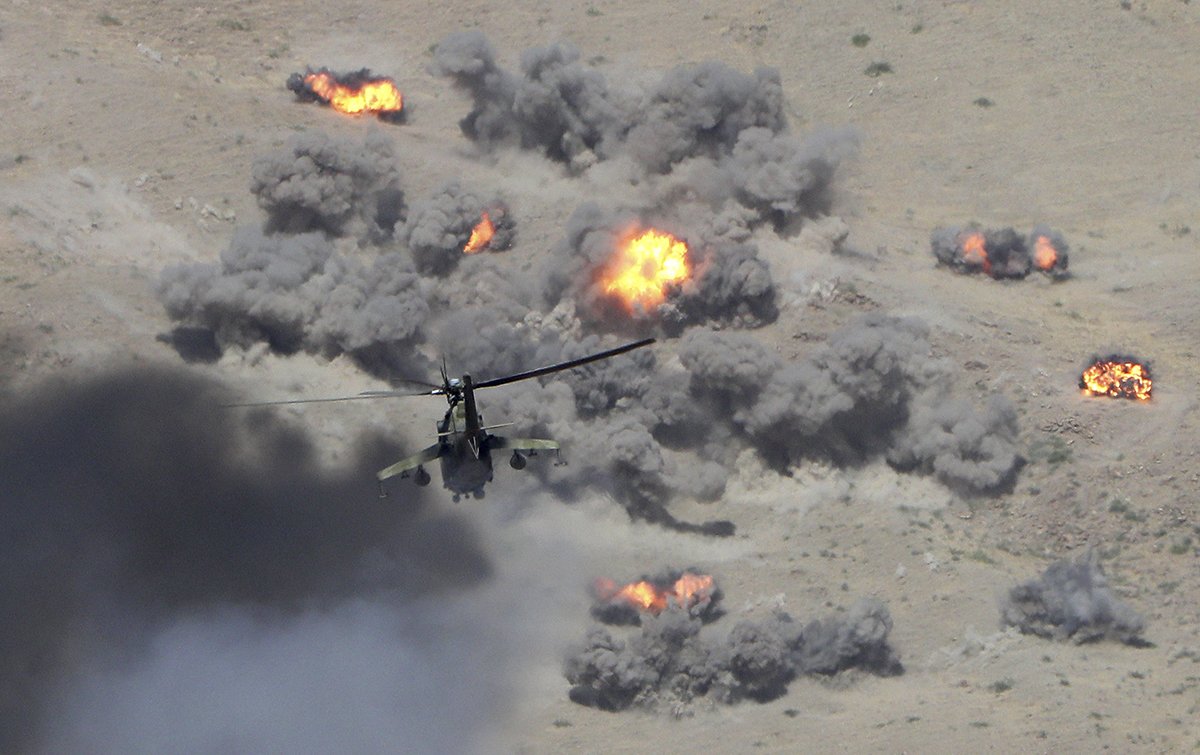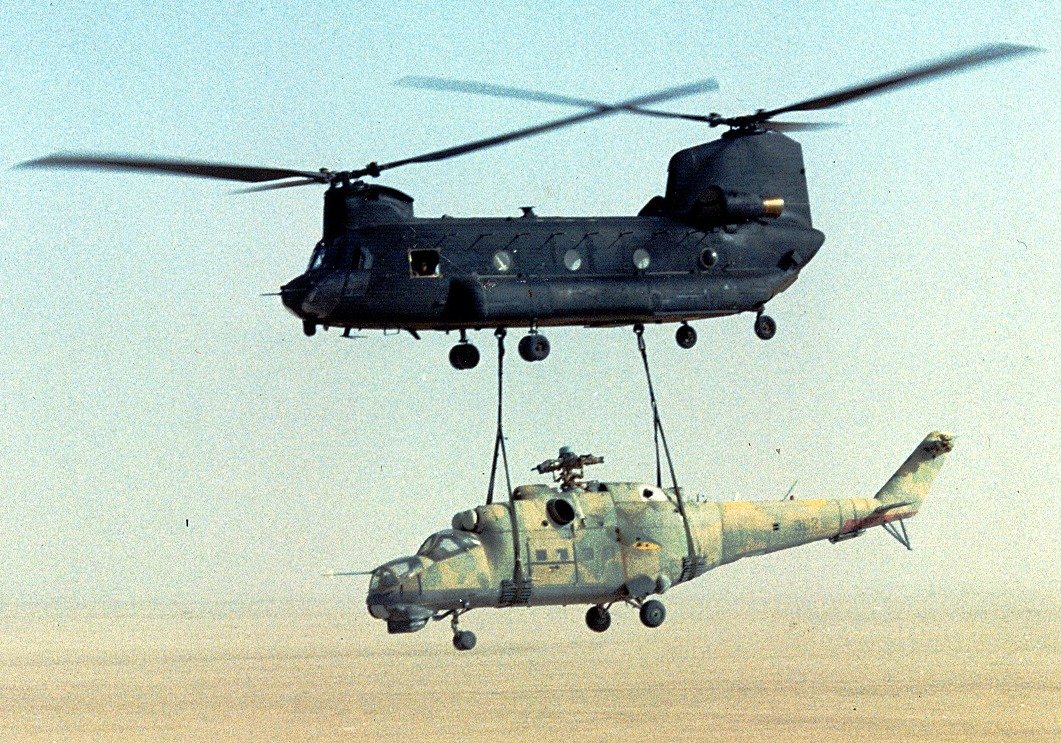
A Russian-made Hind Mi-24 helicopter from the Army Test and Evaluation Center, Threat Support Activity, Las Vegas, Nevada, taxis back after providing simulated hostile threats to search and rescue operations, during the Desert Rescue exercise, Feb. 17, 2000. Photo courtesy of Wikimedia Commons.
For more than 40 years across nearly 30 wars and conflicts, the Russian-made Mi-24 “Hind” helicopter gunship has been one of the most feared airframes in military history. It built its legendary status, however, against the Afghan mujahedeen in ground-attack battles during the Soviet-Afghan War from 1979 to 1989.
“The Soviet Union deployed Hind helicopters in Afghanistan, machines of incredible fire power,” the Detroit Free Press wrote in 1992. “Rebels move mostly at night, and these flying tanks used infrared imaging to devastate rebel forces.”
From the standpoint of the Afghan mujahedeen forces on the ground, these “Hind” helicopters — a code name assigned by NATO and Western intelligence services — were virtually impossible to shoot down with unguided, shoulder-fired rocket-propelled grenades. The massive 18,000-pound, titanium-armored gunships were equipped with a vast weapons arsenal comprising Gatling guns, cannons, rocket pods, and guided missiles. Without foreign intervention, the Afghan mujahedeen resistance didn’t stand a chance against these so-called “flying tanks.”

The Mi-24 attack helicopter was the brainchild of Russian aerospace engineer Mikhail Mil. The inventor adapted the Mi-8 transport helicopter to take the Mi-24 from concept in 1968 to prototype only a year later. His innovations met the Soviet Union’s requirement for an attack helicopter large enough to transport ground troops into battle, while also providing the assault force with close air support.
Initially, the airframe grabbed international attention from aviation experts in 1969 when test pilot German Alferov took flight in the prototype. Over the next decade, the Mi-24 showed off its stunning capabilities in combat. In contrast to the American MH-47 Chinook transport helicopter, the Mi-24 gunship could carry eight foot soldiers and two pilots, but it was remarkably fast too. In 1978, test pilot Gurgen Karapetyan flew an Mi-24A-10 helicopter at a record speed of 228.9 mph, which stood strong for eight years until being broken by a Westland Lynx helicopter in 1986.
In 1978, the Ethiopian Air Force received around 40 Hind helicopters to combat Somali forces in the disputed Ogaden region. These Ethiopian Mi-24As, which were flown by Cuban aircrews, were the first of the type to be flown in combat operations.

The Soviet Union unleashed its new gunship during the bloody, nine-year conflict in Afghanistan. An estimated 1 million civilians, 90,000 Afghan mujahedeen fighters, and 18,000 Afghans troops were killed — many of whom died under fire from Mi-24s. The Afghans called the Mi-24 Satan’s Chariot. The Afghans’ one effective defense against the helicopter gunship proved to be the CIA-provided Stinger missiles, which were supplied through a covert action program called Operation Cyclone.
According to a report from the 1993 edition of the US Air Defense Artillery Yearbook, over a two-and-a-half-year period, mujahedeen Stinger gunners scored “approximately 269 kills in about 340 engagements, a 79-percent kill ratio.”
The Mi-24 gunship was so effective that the US government went to great lengths to get their hands on one. In 1988, a Soviet-made Mi-25 “Hind-D” attack helicopter, a variation of the Mi-24, crashed during a conflict between the African nations of Libya and Chad.
Two US MH-47 Chinooks from the 160th Special Operations Aviation Regiment flew nearly 500 miles at night to the crash site without being detected. Marking a major success for US special operations forces, the top-secret mission, Operation Mount Hope III, retrieved the downed Hind and transported it back the US aboard a C-5 cargo plane.

Matt Fratus is a history staff writer for Coffee or Die. He prides himself on uncovering the most fascinating tales of history by sharing them through any means of engaging storytelling. He writes for his micro-blog @LateNightHistory on Instagram, where he shares the story behind the image. He is also the host of the Late Night History podcast. When not writing about history, Matt enjoys volunteering for One More Wave and rooting for Boston sports teams.
BRCC and Bad Moon Print Press team up for an exclusive, limited-edition T-shirt design!
BRCC partners with Team Room Design for an exclusive T-shirt release!
Thirty Seconds Out has partnered with BRCC for an exclusive shirt design invoking the God of Winter.
Lucas O'Hara of Grizzly Forge has teamed up with BRCC for a badass, exclusive Shirt Club T-shirt design featuring his most popular knife and tiomahawk.
Coffee or Die sits down with one of the graphic designers behind Black Rifle Coffee's signature look and vibe.
Biden will award the Medal of Honor to a Vietnam War Army helicopter pilot who risked his life to save a reconnaissance team from almost certain death.
Ever wonder how much Jack Mandaville would f*ck sh*t up if he went back in time? The American Revolution didn't even see him coming.
A nearly 200-year-old West Point time capsule that at first appeared to yield little more than dust contains hidden treasure, the US Military Academy said.












